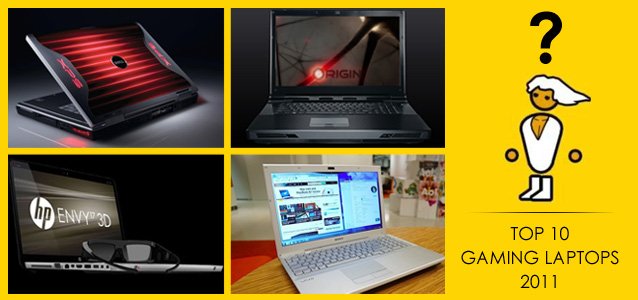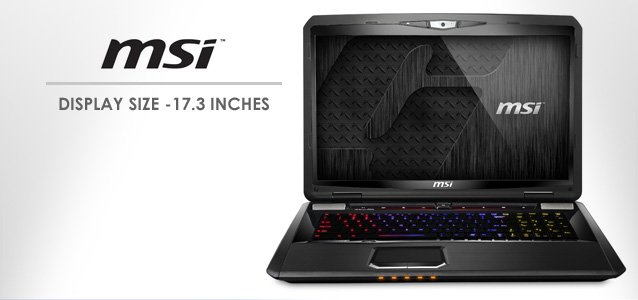


Everyone knows that Windows desktops are the primo option for gaming. Since everyone already knows this, there is no reason to talk about your bajillion gigabyte Intel Radeon Xtremasaurus Rex 10K in RAID DOUBLE ZERO in the comments section. This article isn’t for any of you. It’s for those of us that have made the conscious decision that there is a world outside of Warcraft, Ma’s basement, or what have you. This is all about gaming laptops. Here are five options for heavyweight, desktop replacements. A second set of five laptops pack a bit less oomph, but are at, or below 14 inches in size. That means your (possibly imaginary) significant other could pick it up, and move it (away from you.)
Desktop Replacements

Toshiba’s Qosmio line suffers from a common problem among gaming laptops. It’s ugly. It’s a glossy red brick on the outside, and a fingerprint friendly gloss black on the inside. But like Disney, or whoever said, it’s what’s inside that counts. The almost sixteen inch LCD runs in 1080p. The panel has a trick to it though. It is capable of outputting glasses-free 3D content in 720p. The webcam tracks eye movements to avoid the loss of the auto-stereoscopic image that haunts 3DS users. In a more practical trick, Toshiba packs Sleep and Charge technology into the Qosmio’s USB 3.0 port. This port can funnel power through the USB, even when the computer is powered down.
That’s what sets the Qosmio apart, but what about the bits that matter? Specs look sharp for the price point. A second-gen Core i5 2430 handles processing duties, while a NVIDIA GT 540M powers through games. A Blu Ray drive comes standard for showing off that 1080p screen. Toshiba packs six gigs of DDR3 RAM in the Qosmio. The disappointing point is in the hard drive. The capacity is fine at 750 gigabytes, but the HDD runs at a measly 5400 RPM. Slow speeds in that department won’t do much for loading times in games.

This is the most powerful PC on this list. Origin is a small custom PC manufacturer that builds startlingly fast laptops and desktops. The EON 17 is built using desktop class processors. The bottom rung processor is the Core i7 950 Quad-Core that runs at a speedy 3.06 GHz. The computer scales up to unbelievably high levels as well. The EON 17 can be equipped with Intel’s Xeon six core processors, the absolute best graphics cards both NVIDIA and AMD offer, up to three hard drives in RAID 0 configuration and options don’t end there. Here’s the rub that sort of power comes at two prices. The first is monetary, these computers start at over 2300$ (the EON 17 tops out at 11,274$.) The second price is heft, the EON 17 weighs in at a shoulder crushing twelve(!) pounds, and has a thickness over two inches.

HP struck gold with the design of the Envy series of laptops. The striking, aluminum–clad beauties are HP’s high-water mark in hardware design. The Chiclet keyboard is not ideal for gaming, but it is backlit and a dream to type on. Granted, the Envy borrows a lot of styling from Apple’s Macbook Pro line, but you know what Steve Jobs said about what great artists do. The Envy 17 has great specs even at a base configuration. The Intel Core i5-2430M keeps things spinning at a healthy 2.4GHz. The Intel silicon works in tandem with 6 gigs of DDR 3 RAM and a 1 gigabyte AMD Radeon 6850M. The display clocks in on the low end for 17 inch panels. It starts at 1600 by 900 but can be upgraded to a proper 1080p panel if you ask nicely and give HP 150$. That’s a good example of the conundrum the Envy 17 leaves a buyer in. It’s the best looking of these heavy-hitting laptops but it seems to sacrifice oomph for aluminum durability and class. Is the trade-off worth it? That depends on priorities. If gaming is the one and only requirement, then go elsewhere to get more bang for the buck.

ASUS’ monstrous 17 incher looks like a stealth bomber with all of the sexy stripped out. This big black behemoth is an ugly duckling in every sense of the word. The PC is fat, almost ten pounds, and nearly two and a half inch thick. It’s equipped with giant fans all along it’s’ over ample rear, (afterburners, if we are continuing the jet metaphor.) Supposedly, this design keeps the device’s noise and heat down, but I don’t imagine the person sitting across from you being particularly pleased. Even on a desk, is it really a good idea to be blowing all that hot air into the usually small space between the PC and the wall?
Specs-wise the ASUS drops a bomb on today’s hot games. The Core i7 inside is augmented by a mean, 3 gigabyte, NVIDIA GTX560M. Also bordering on the excessive is the 12 gigabytes of DDR3 RAM, but don’t worry, it’s expandable to 16 gigabytes.

Top to bottom, MSI’s G-Series laptops are engineered for extreme gaming. The SteelSeries keyboard is loaded with a programmable LED panel that has a 30 color gamut. Backlit keyboards are obviously great for late-night gaming sessions, and 30 color backlit keyboards are even better for being obnoxious. The MSI G-Series is another gaming laptop that is built like a brick. It seems to be the common trade-off for the extreme specs. This one packs in a monstrous Core i7-2670QM, paired with a 1.5GB NVIDIA GTX570M. Toss in 12 gigs of DDR3 RAM and you have a whole bunch of reasons that MSI’s profile is rising in gaming laptops.
Continued on Page 2.

Page 1 Page 2




 How to use the Trade In Detectives Price Checker
How to use the Trade In Detectives Price Checker Review: The Sims 4
Review: The Sims 4 The Merryweather Heist. Scouting the Port Mission Guide In GTA V
The Merryweather Heist. Scouting the Port Mission Guide In GTA V Trine 3: The Artifacts of Power (PC) overview
Trine 3: The Artifacts of Power (PC) overview Absolute Zero - The Freezing Point of Games
Absolute Zero - The Freezing Point of Games